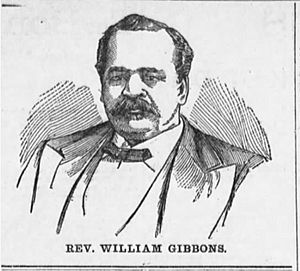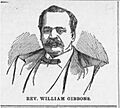William D. Gibbons facts for kids
Quick facts for kids
Rev. William Gibbons
|
|
|---|---|
 |
|
| Born | 1825 |
| Died | 1886 (aged 60–61) Washington, D.C.
|
| Burial place | Charlottesville, Virginia |
| Occupation | Baptist Minister |
| Years active | 1866–1886 |
| Spouse(s) | Isabella Gibbons |
William Gibbons (1825 – June 28, 1886) was an important Baptist minister. He was born into slavery but became a very successful leader in Charlottesville, Virginia, and Washington, D.C. He was married to Isabella Gibbons, who was also a respected teacher.
Contents
William Gibbons' Early Life and Slavery
William Gibbons was born in Albemarle County, Virginia, in 1825. He was born into slavery, which meant he was not free. We do not know who his parents or first owners were.
Life as an Enslaved Person
In the 1840s, William was sold to Dr. Henry Howard. Dr. Howard was a professor at the University of Virginia. William was then hired out to William Holmes McGuffey, who was Dr. Howard's son-in-law.
William worked as a butler. Even though it was against the law, his owner allowed him to preach to students. He later shared that he became a minister in 1844. People liked him very much. He was a favorite among everyone.
Becoming a Minister After Slavery
After slavery ended, William Gibbons was officially made a minister in 1866. He was sometimes called a "lay minister" or "licentiate." A licentiate is someone who has official permission to work in a certain job.
Leading the First Black Church in Charlottesville
In 1867, William Gibbons was asked to lead the First Baptist Church of Charlottesville. This was the first Black church in the city. Before this, Black worshippers had to sit in the balcony of the church. They also felt that the minister treated them unfairly.
After the Emancipation Proclamation in 1863, Black church members wanted their own church. The church split into separate Black and White groups. They both used the same building at first. William Gibbons became the first Black minister of the Black congregation. This happened after the Union military government changed Virginia's laws.
The Black church soon got its own building. It was the old Delevan Hotel. For a few years, it was called the Delevan Baptist Church. Isabella Gibbons, William's wife, taught at a school in the church basement.
Ministry in Washington, D.C.
William Gibbons moved to Washington, D.C., in 1867. The next year, he became the pastor of the Zion Baptist Church. Some records show he might have stayed in Charlottesville until 1870. It is hard to know the exact dates for all the pastors from that time.
Moving to Washington, D.C.
William's wife, Isabella, taught at a school in Charlottesville. In 1874, her school faced money problems. The Delevan Hotel building, where her school and William's church were, was torn down in 1876. A new building was not ready until 1884.
Around 1875, William and Isabella likely moved to Washington, D.C. This is when mentions of Isabella as a teacher in Charlottesville stop. At the same time, William is mentioned as a pastor in Washington.
Growth of Zion Baptist Church
William Gibbons stayed at Zion Baptist Church until he died in 1886. Under his leadership, the church grew a lot. It went from 200 members to 1,700 members.
When he passed away in June 1886, many people attended his funeral. The Washington Post reported that 10,000 mourners were there. The National Republican estimated 5,000 people. They said it was almost impossible to get close to the building.
The church's board members went with William's body to Charlottesville. He was buried in Oakwood Cemetery. Isabella's body was also moved from Washington to Charlottesville after she died in 1890. She was buried next to him.
William and Isabella Gibbons' Legacy
In 2015, the University of Virginia honored William and Isabella Gibbons. They named a new student residence hall "Gibbons House." Inside the building, there are photos of them. There are also signs and a plaque that tell their story.
Images for kids


